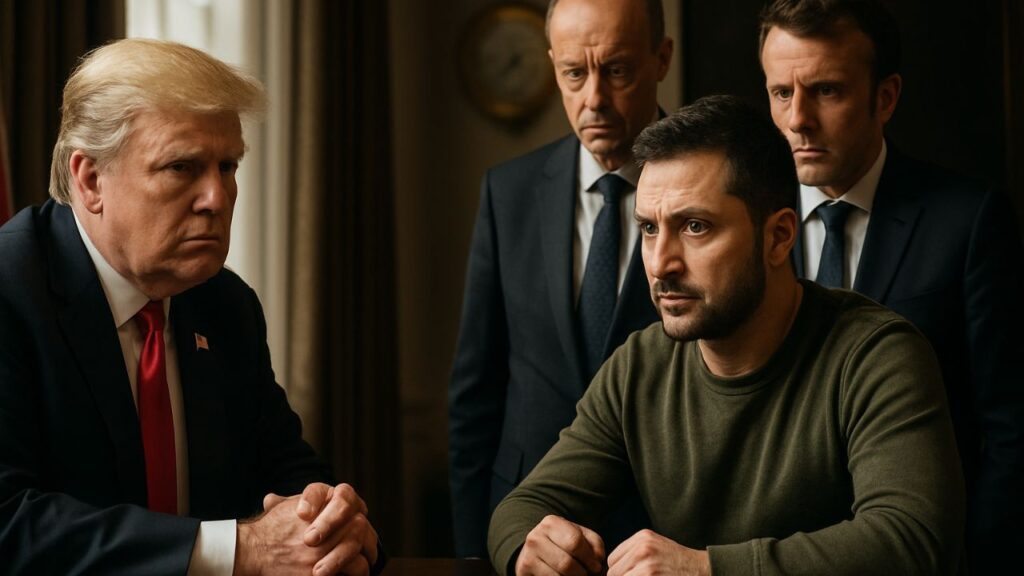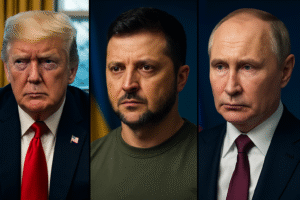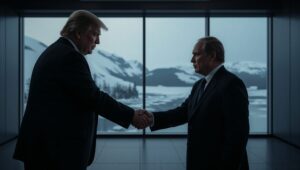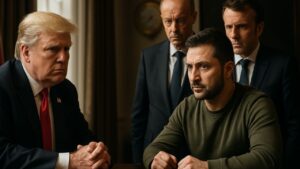In Show of Unity, European Leaders Join Zelenskyy for High-Stakes White House Peace Talks with Trump

Ukrainian President Volodymyr Zelenskyy (right) and U.S. President Donald Trump (left) hold a high-stakes meeting at the White House on August 18, 2025, to discuss a potential peace agreement with Russia.
WASHINGTON – Ukrainian President Volodymyr Zelenskyy, accompanied by a powerful delegation of top European leaders, is meeting with U.S. President Donald Trump at the White House on Monday to navigate a perilous new phase in the diplomacy aimed at ending Russia’s war in Ukraine. The summit comes just days after President Trump’s meeting with Russian President Vladimir Putin, which triggered alarm among Western allies following a shift in U.S. strategy toward a peace deal that could involve Ukrainian territorial concessions.
The high-stakes meeting is intended to bolster Kyiv’s negotiating position and prevent a repeat of a previous encounter between the U.S. and Ukrainian leaders that was described as “disastrous”. The unified European front—including leaders from France, Germany, the United Kingdom, and the E.U.—signals deep concern over President Trump’s recent talks with Putin in Alaska, where Trump abandoned his demand for an immediate ceasefire and urged Ukraine to “take the deal”. President Zelenskyy remains firm in his position, insisting on an immediate ceasefire before any comprehensive peace agreement and consistently rejecting proposals to surrender Ukrainian land.
The talks in Washington are expected to delve into the specifics of a potential peace framework, including Russia’s demands for land and the details of future security guarantees for Ukraine. After his meeting with Putin on August 15, Trump’s envoy claimed Russia had agreed to “Article 5-like protection” for Ukraine and “land swaps,” a claim Moscow has not publicly confirmed. However, sources briefed on Russia’s position indicated Putin may be willing to freeze most front lines in exchange for Ukraine ceding full control of the Donetsk region. Russia has consistently demanded that all four of its illegally annexed regions—Donetsk, Luhansk, Zaporizhzhia, and Kherson—be ceded to its control.
European leaders have been vocal in their support for Ukraine’s sovereignty. “If we are weak with Russia today, we are preparing the conflicts of tomorrow,” said French President Emmanuel Macron, reiterating that Kyiv cannot be forced into territorial concessions through third-party negotiations. That sentiment was echoed by European Commission President Ursula von der Leyen, who met with Zelenskyy in Brussels on Sunday and pledged, “We will continue to support you for as long as it takes”. The unified visit to Washington is a clear attempt to ensure Europe is included in future peace talks and to counter what they fear is a U.S. pivot that could legitimize Putin’s position without any tangible peace gestures.
The diplomatic push occurs against the grim backdrop of a conflict that has raged for over three and a half years, leaving more than one million people killed or wounded. The war began in earnest with Russia’s annexation of Crimea in 2014 and its full-scale invasion in 2022, despite theoretical security guarantees given to Ukraine when it surrendered its Soviet-era nuclear arsenal in 1994.
U.S. officials have presented the meetings as a positive step. Secretary of State Marco Rubio stated he saw “enough movement” to justify the summit, while denying European leaders were attending “to keep Zelensky from being bullied”. However, criticism of the administration’s approach has been sharp. Democratic Senator Chris Murphy called the Trump-Putin summit “a great day for Russia,” arguing Putin left with “zero commitments made and zero consequences”.
The outcome of Monday’s meeting could fundamentally alter the trajectory of Europe’s deadliest conflict in 80 years. For residents in Ukraine, the stakes are deeply personal. Many in Kyiv express a profound distrust of Putin and reject any peace that involves ceding territory for which countless soldiers have died. As the leaders meet, the negotiations will not only define Ukraine’s future borders but also test the strength of the transatlantic alliance and shape the security framework of Europe for years to come.






